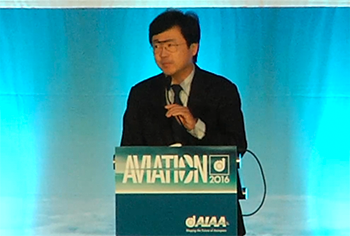The HondaJet: How One Engineer’s Dream Project Became a Reality Written 14 June 2016
Keynote speaker: Michimasa Fujino, president and CEO, Honda Aircraft Co.
by Hannah Godofsky, AIAA Communications

It’s rare in the modern world that any manufactured vehicle is the dream project of only one engineer. Huge teams of people working with large companies design most aircraft. But the HondaJet has been the pet project of Michimasa Fujino since 1997, when he first sketched out a design.
Nearly 20 years later, his dream is finally a reality. Fujino is now president and CEO of Honda Aircraft Co., an aircraft manufacturer headquartered in Greensboro, North Carolina, where the HondaJet was awarded FAA certification and is being produced at a rate of two per month. Fujino said there are plans to double that this year.
“Honda serves as a mobility company,” Fujino said June 14 at AIAA AVIATION 2016 in Washington, DC, as he showed how Honda had gradually scaled from motorcycles to automobiles and, now, to aircraft. “It is a big jump from motorcycles.”
Fujino explained that he studied aeronautical engineering in schools but that in Japan, opportunities for the field were limited. He said he decided to join Honda because the company offers more options for young engineers.
“I saw some opportunity to design, build and sell,” he said.
The light-jet market is ideal for Honda because the planes are less expensive, and there is room to improve over existing products. The HondaJet spans less than 40 feet and is just shy of 43 feet long. Fujino said it’s smaller than existing business jets yet has more cabin space and is the fastest jet in its class.
Honda has taken full advantage of automation and computing in HondaJet’s manufacturing process, according to Fujino. The technicians who work on the final product have tablet computers that show CAD models of what they are working on, and robots paint the planes, he explained.
“Robots give us a very consistent surface,” Fujino said, showing images of HondaJets rolling off the production line.
The HondaJet has over 3,000 flight hours testing in more than 70 locations in the U.S.; customers throughout North America, South America and Europe have taken delivery of the final product; and a single HondaJet flew a 26,000-nautical-mile trip on a world tour without a single dispatch issue. It’s an engineer’s dream come true for Fujino.
Video
